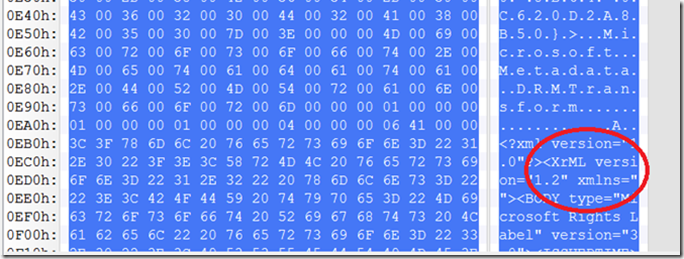.MSG File Format, Rights Managed Email Message (Part 3)
In Part 2, I concluded my dissection of the rights managed email message example, with locating the DRMTransform\Primary stream. At the time, I didn’t go into much detail because I was focused on a) finding the message.rpmsg attachment and b) showing how to decompress the binary data to yield the storage container in which that stream lives. To pick things up where I left off, I refer back to [MS-OXORMMS] 3.1.4.1.3, the diagram of the storage container. The storage and stream listing below shows recognizable names but some of these are actually shared storage structures defined in [MS-OFFCRYPTO].
Figure 1 Showing the storage and stream layout of the message storage container.
So for the scope of this storage container that we’ve decompressed, you will see that the following layered specifications are used by Outlook (from bottom to top):
[MS-CFB] |
[MS-OFFCRYPTO] |
[MS-OXORMMS] |
[MS-OFFCRYPTO] defines the DataSpaces and TransformInfo storages. The DataSpacesMap stream contains entries that name the streams containing the content being transformed as well as the names of DataSpacesInfo based streams that point to TransformInfo references which describe the transforms, in order, that are applied to the corresponding content in the map. This is the general structure used by Office applications for consistency when doing protection and transformations on content.
Figure 2 DataSpaceMap stream, showing one entry that consists of the content stream “DRMContent” and the data space information stream “DRMDataSpace”.
Figure 3 DRMDataSpace stream showing a DataSpaceDefinition structure with one TransformReferences struct pointing to “DRMTransform”.
What this means is that any Office application that transforms or protects part or all of its content must first build a structure around [MS-OFFCRYPTO] 2.1. On top of that, the application then defines one or more transforms that can be applied to the content. In the case of Outlook and it’s rights managed message, DRMTransform specifies the transformation that was or will be done on the content in DRMContent. Although [MS-OXORMMS] specified the names DRMTransform and DRMContent, interoperating applications will know to find these transformations by looking at the DataSpaceMap and DataSpaceInfo written according to [MS-OFFCRYPTO]. This allows for consistency across applications.
Figure 4 DRMTransform\Primary stream showing
The “Primary” stream is named by [MS-OFFCRYPTO] 2.1.1 as the stream containing the transformation algorithm used to transform the content. There can be other streams besides “Primary” if needed by the application. The first part of the Primary stream is a required TransformInfoHeader struct. This contains two strings, an id (partly shown above) and a name for the transfom. In this case, it’s called “Microsoft Metadata DRMTransform”. After that, the stream can contain other structures and data that define the algorithm.
In the previous blog entry, I pointed out the “XrML…” string and identified this as XrML. This is the transform. It’s a format based on XML that tells the application how to get access to the original email message and what rights to apply have once decoded. XrML is a standard language used to specify rights on many kinds of digital content and an overview of the language can be found in the XrMLTechnicalOverview PDF file.
For this and the next several installments, I will go a little further explaining the relationship between [MS-OXORMMS] and [MS-OFFCRYPTO] and investigate the various elements and attributes in this XrML string so that the reader can get some understanding of how XrML works and it’s power. But to wrap up this session, some history on XrML.
Xerox PARC, where it all began
In 1994, a patent was filed by Xerox which contained a language called DPRL for Digital Property Rights Language. This was based on research being done by Xerox PARC’s Mark Stefik, who was working on trusted systems for secure digital commerce. DPRL, originally, was expressed in the LISP programming language. It wasn’t until 1998 that Xerox released version 2.0 of DPRL that was expressed in XML. This version of DPRL was licensed to ContentGuard which was a company founded by Microsoft and Xerox. In 2001, DPRL evolved into the published XrML 1.0.



